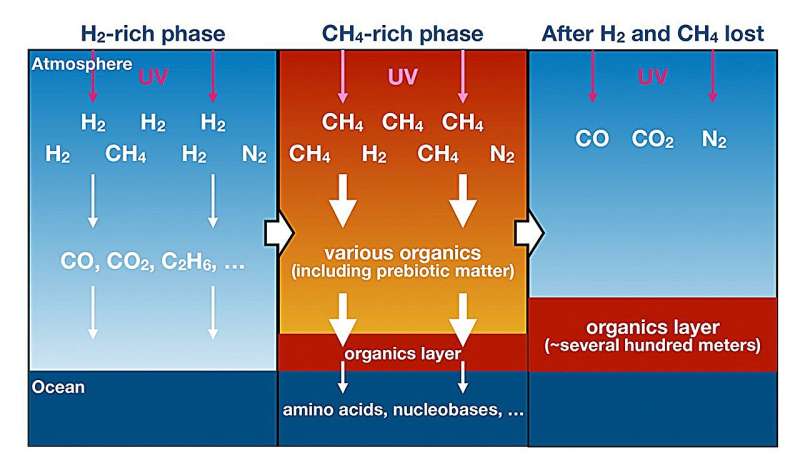The key to unlocking the secrets of distant planets starts right here on Earth. Researchers at Tohoku University, the University of Tokyo, and Hokkaido University have developed a model that considers various atmospheric chemical reactions to estimate how the atmosphere—and the first signs of life—evolved on Earth. The study is published in Astrobiology.
“Ancient Earth was nothing like our current home,” explains Shungo Koyama from Tohoku University, “It was a much more hostile place; rich in metallic iron with an atmosphere containing hydrogen and methane.” These molecules contain an important clue to how life was initially formed.
When exposed to solar ultraviolet (UV) radiation, they undergo a chemical reaction that produces organics (also known as the “building blocks of life”). Part of these organics were precursors to essential biomolecules, such as amino acids and nucleic acids.
However, understanding the role of UV radiation is difficult. First, this type of atmosphere is unstable and likely underwent rapid changes due to atmospheric chemical reactions. Second, when UV radiation efficiently breaks down water vapor in the atmosphere and forms oxidative molecules, the precise branching ratio and timescale has not been determined.
In order to address these issues, a 1D photochemical model was created to make accurate predictions about what the atmosphere was like on Earth long ago.
The calculation reveals that most hydrogen was lost to space and that hydrocarbons like acetylene (produced from methane) shielded UV radiation. This inhibition of UV radiation significantly reduced the breakdown of water vapor and subsequent oxidation of methane, thus enhancing the production of organics.
If the initial amount of methane was equivalent to that of the amount of carbon found on the present-day Earth’s surface, organic layers several hundred meters thick could have formed.
“There may have been an accumulation of organics that created what was like an enriched soup of important building blocks. That could have been the source from which living things first emerged on Earth,” Tatsuya Yoshida of Tohoku University proposes.
The model suggests that the atmosphere on ancient Earth was strikingly similar to what we see currently on neighboring planets Venus and Mars. However, despite their proximity, Earth evolved into a completely different environment.
Researchers are trying to understand what makes Earth so special. As such, this model allows us to deepen our understanding of whether atmospheric evolution and the origin of life on Earth are unique or share common patterns with other planetary systems.
More information:
Tatsuya Yoshida et al, Self-Shielding Enhanced Organics Synthesis in an Early Reduced Earth’s Atmosphere, Astrobiology (2024). DOI: 10.1089/ast.2024.0048
Provided by
Tohoku University
Citation:
How life began on Earth: Modeling the ancient atmosphere (2024, October 30)
retrieved 30 October 2024
from https://phys.org/news/2024-10-life-began-earth-ancient-atmosphere.html
This document is subject to copyright. Apart from any fair dealing for the purpose of private study or research, no
part may be reproduced without the written permission. The content is provided for information purposes only.

